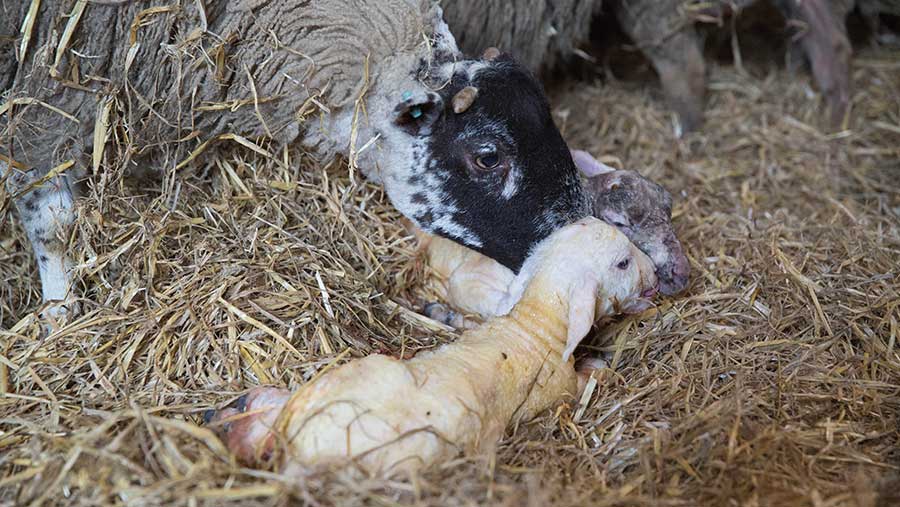Expert advice for lambing amid iodine shortage
 © Tim Scrivener
© Tim Scrivener The Sheep Veterinary Society has warned about shortages of strong (10%) iodine ahead of lambing due to production ceasing in Chile.
If farmers can source 10% iodine, they could face having to pay as much as quadruple the normal price.
See also: 7 key lambing diseases: How to prevent and treat them
Lower iodine concentrations (below 7%) may be available, but vets warn these are less effective at drying and disinfecting the navels of newborn lambs.
Sheep Veterinary Society president David Wilson and sheep vet Fiona Lovatt from Flock Health give advice on what sheep farmers can do ahead of lambing.
1. Ensure adequate supply of colostrum
Manage ewe body condition and nutrition to ensure ewes have a plentiful supply of good-quality colostrum at lambing.
Speak to your vet about analysing forage and carrying out metabolic profiling later in pregnancy.
Metabolic profiling should be completed on sheep three to four weeks before lambing to check the ration being supplied in late pregnancy is meeting requirements.
Test eight individual ewes from each group (singles, twins and triplets).
“The singles are often forgotten, because our focus is, quite rightly, on the twins and triplets.
“However, singles are still quite important, especially if you want to foster lambs onto them,” says Dr Lovatt, who sampled 1,300 ewes and found ewes carrying singles had the poorest-quality colostrum.
A 75kg ewe carrying twins requires 18MJ of energy and 130g of protein a head a day in the week before lambing.
With concentrate feed costing more than £400/t, farmers are being urged to analyse forage to match bought-in feed to requirements and be as precise as possible.
“Some people massively overfeed concentrates, and they can’t afford to do that.
“Make sure there is sufficient energy in the last six weeks and sufficient protein for the last couple of weeks for colostrum,” she adds.
2. Do not use blanket antibiotics
Tetracycline antibiotics spray should not be used to treat newborn navels. They do not dry effectively, and it is an unnecessary use of antibiotics.
Neither should any oral antibiotics be used prophylactically.
“You can’t decide ahead of lambing that healthy lambs need a treatment.
“Routine prophylactic use is completely unnecessary, and it is such a short-term sticking plaster.
“Antibiotics should only be used if they are needed. We have been far too liberal in the past and we are seeing increasing resistance,” adds Dr Lovatt.
Farmers are advised to speak to the prescribing vet if they do encounter disease at lambing.
3. Cleanliness
Navel dressing is important, but most cases of joint ill and other similar conditions follow the invasion of bacteria via the tonsils or intestinal tract from a heavily contaminated environment.
It is, therefore, essential to keep the lambing environment clean and dry, and get a good supply of colostrum into lambs, says Mr Wilson.
“If lambing inside, this can include ensuring good ventilation and drainage, keeping group pens well bedded, and cleaning, disinfecting and rebedding individual pens between ewes.
“If managed well, lambing outside can help reduce infectious diseases.”
4. Alternatives
There are alternatives on the market, but there are limited data on their use in lambs.
Various studies have shown the speed of drying is critical to reducing joint ill and navel ill.
“A 10% iodine dries the navel quickly. If the navel isn’t dry, then the product is no good,” warns Dr Lovatt.
Farmers who are forced to use alternatives are being advised to scrutinise the safety data sheet and ask the following questions:
- What is the speed of drying?
- What data are there behind it?
- Have trials been carried out showing its efficacy?
Lambing webinar
The National Sheep Association is hosting a lambing webinar on the 23 January giving best-practice advice. Find more information and how to join online.
Colostrum
Make sure lambs receive 50ml/kg of colostrum as soon as possible after birth and within 4-6 hours. In 24 hours, a newborn lamb must receive the equivalent of 200 ml/kg body weight in colostrum.
Source: AHDB
Find more advice on colostrum management online.
